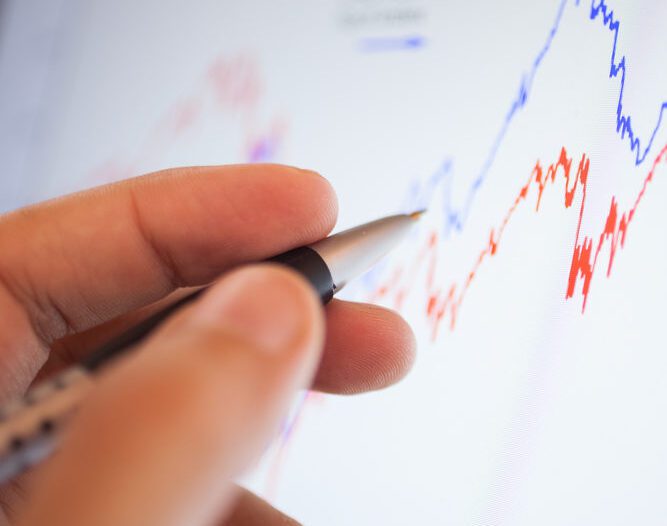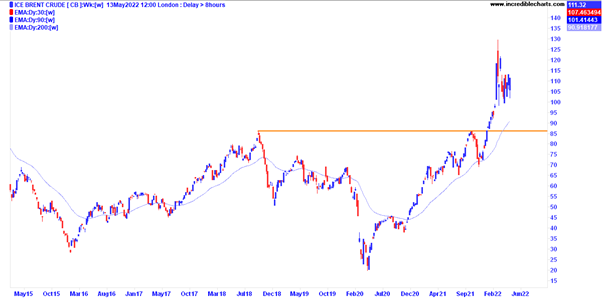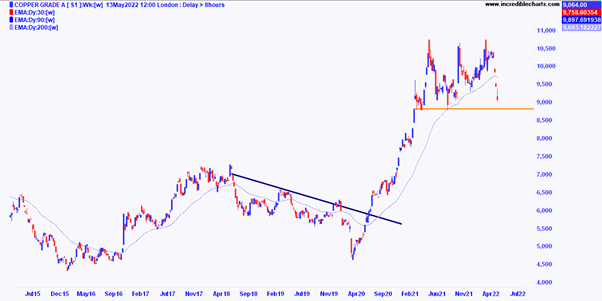In today’s Money Morning…central bank-induced panic…clues that inflation is easing off…my game plan…and much more…
The fear in the markets is palpable.
Investors are selling first and asking questions later.
To me, that spells opportunity.
If I’m right on how this plays out, the second half of this year will be a good time to load up on a bunch of fantastic stocks.
A chance to snap up bargain basement companies that will define the world we live in over the next decade.
But right now, they’re being sold down willy-nilly.
Will they fall further?
They could, perhaps even a lot further.
But the deeper they fall, the better the gains you could make in the years ahead.
So when do you strike?
That’s what I want to talk about today…
Central bank-induced panic
First, a recap…
As you probably know, the spur for the current panic is the belated actions of central bankers.
They’ve finally started lifting interest rates to combat sky-high inflation.
The market is worried…
How high will rates go?
How long will they tighten for?
Will this even work at bringing down inflation?
These are the topics on everyone’s mind right now.
And while they mull over the answers, many have hit the sidelines.
Speculative sectors like technology, biotech, and cryptocurrencies have been the hardest hit. The technical reason is that the present value of future cash flows falls as interest rates rise.
But in reality, it’s just the fickle market moving from greed to fear.
There’s no point complaining about that fact. It’s just the way human nature works.
But you can use it to your advantage.
Just as some stocks were overvalued on the way up, there’ll be some huge bargains on the way down too.
At some point, the Fed will put a brake on the rate rises.
And as my colleague Greg Canavan noted in our Insider service for paid subscribers last week:
‘Because once the Fed realises it has inflation under control, it will stop tightening. Bonds yields will fall sharply, and asset prices will start rising again.
‘I don’t know when this will happen. But paradoxically, the more the Fed raises, the closer it gets to cutting again and turning on the monetary taps.’
Forget all the talk of seven more rises, my gut feeling is this will happen after two more half-point rate rises (a 1% increase).
The truth is there’s too much debt around these days to get back to ‘normal’ levels. Bond markets will crash if the Fed gets too aggressive.
I think they’re trying to scare markets into a slowdown with tough talk without actually having to follow through. It’s a high stakes game of chicken.
That’s my thesis, and it could be wrong.
To validate it, we’ll need to see inflation come down first.
But as Greg says, once the market gets a sniff of this, you can rest assured some beaten-down stocks will come back in vogue very fast.
My strategy is to watch these three charts carefully to tell me when to strike…
Clues that inflation is easing off
OK, chart number one…
Oil:
|
|
|
Source: Incredible Charts |
Energy costs are big inputs into pretty much the cost of everything. And despite the push into renewables, oil still dominates.
While the Russia-Ukraine situation is complicating things, if the oil price starts falling, it would be a good leading indicator to follow.
A fall below that US$86 support level would be a big tell demand is slowing down.
Next up…
Copper:
|
|
|
Source: Incredible Charts |
‘Doctor Copper’ has historically been a good indicator of the health of the economy.
It’s used for a wide variety of uses across many different industries, including the massive construction industry.
And it’s actually a key component in the push to electric vehicles (EVs). EVs use four times as much copper as conventional internal combustion ones.
Incidentally, one issue we’ve been mulling over in the office recently is that the transition to green energy is actually a very material-intensive process.
As CIM Magazine reported:
‘A strong end to the year and accelerated prices in January have led to higher commodities forecasts, and metals such as copper, nickel and lithium are benefiting from “the red-hot EV market”.’
Now that might not be great for inflation, but it might be good for some ‘battery material’ miners listed on the ASX.
So if they get caught up in the inflation worry selldown, I think an opportunity is there for the taking at some stage.
But right now, copper is definitely coming off the boil, and an unexpectedly large slump in German factory orders last week has definitely sparked some jitters.
As reported in Yahoo! News:
‘“If you are in search of bad news, just have a look at German macro data,” Carsten Brzeski, global head of macro research at ING, said in an emailed note. “We continue to expect a contraction of the German economy in the second quarter.”’
Finally, a slightly unusual one…
Wheat:
|
|
|
Source: Market Insider |
Like petrol prices, the price of food is a big talking point around kitchen tables.
And wheat is one of the most important inputs into what the world eats. It’s used to make bread, noodles, pasta, cereal, crackers, and many other foods.
It’s also used in non-food production like lotions, lip gloss, and baby powder.
But food is the big worry, especially in countries like India.
With wheat prices soaring, last week India took the major step of banning exports to make sure domestic users had supply first.
The knock-on effect of a high wheat price is that it might raise the prices of other foods.
As Dr Wafa Hakim Orman, an Associate Professor of Economics at the University of Huntsville, noted:
‘Unless this is resolved reasonably soon, you can expect food prices to go up as well.’
This, of course, will add to inflation.
However, the current high prices are already nudging some customers to switch to cheaper alternatives like rice, manioc flour, and sorghum.
In short, market forces will kick in eventually. Some demand will fall away, and I’d expect supply to ramp up to take advantage of high prices as soon as farmers can do so.
Which is why wheat futures are a key item to watch…
My game plan
Look, no one knows the future.
Maybe inflation remains stubbornly high and central banks tighten a lot further than I think they will.
Perhaps we will finally get a big crash the doomsayers have long warned us about?
Anything is possible in markets, and only a fool invests with certainty.
So my game plan right now is to be patient.
First, I build a watchlist of exponential stocks with big growth prospects. I’m trying to look two or three years ahead to see what areas are going to disrupt entire industries.
I’m talking about areas like robotics, artificial intelligence, web 3.0, synthetic biology, quantum computing, renewables, and the like.
I’m also looking at mining stocks that are looking for the materials these industries need.
One big caveat:
An important criterion in bad times is that I want to find companies with a healthy cash balance.
Luckily, a lot of speculative companies used the bull market to raise cash.
For example, a synthetic biology company in the US I like called Ginkgo Bioworks [NASDAQ:DNA] is currently valued at US$4.22 billion and has about US$1.5 billion in the bank.
That’s enough runway to see if they can implement their plans over the next year or two. A big down market might even present cashed-up companies with cheap acquisition opportunities, too, as investor capital becomes scarcer.
And as soon as there’s an indication central banks are going to slow down their tightening, I will strike hard in my chosen companies.
When will that be?
Who knows?
Perhaps there’ll be a ‘blood in the streets’ moment first. In a way, that’ll mean even more opportunity if you hang tight.
For now, I suggest you watch those three charts carefully…
Good investing,
 |
Ryan Dinse,
Editor, Money Morning
Ryan is also editor of New Money Investor, a monthly advisory aimed at helping investors take an early-mover advantage as decentralised finance and digital money take over the world. For information on how to subscribe and see what Ryan’s telling his subscribers right now, click here.




